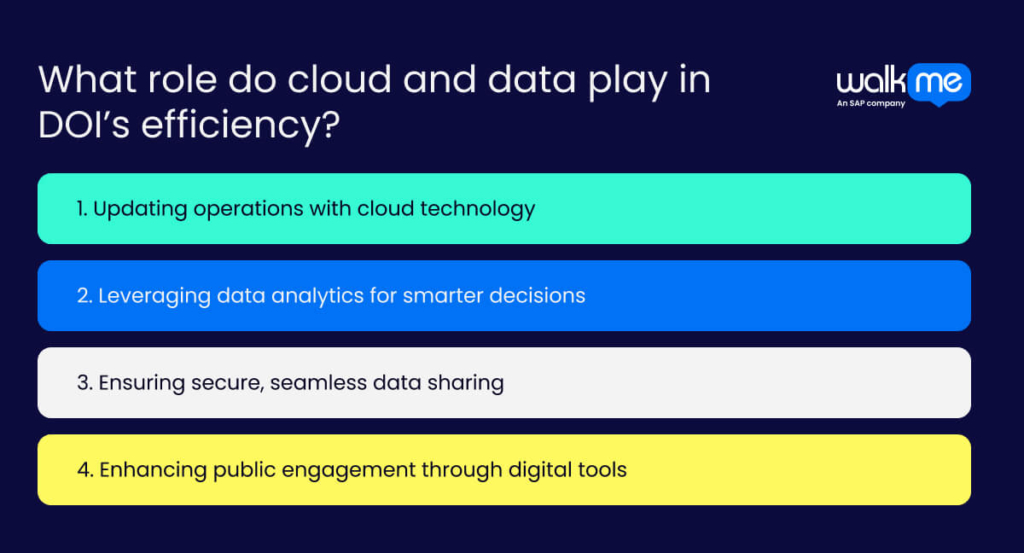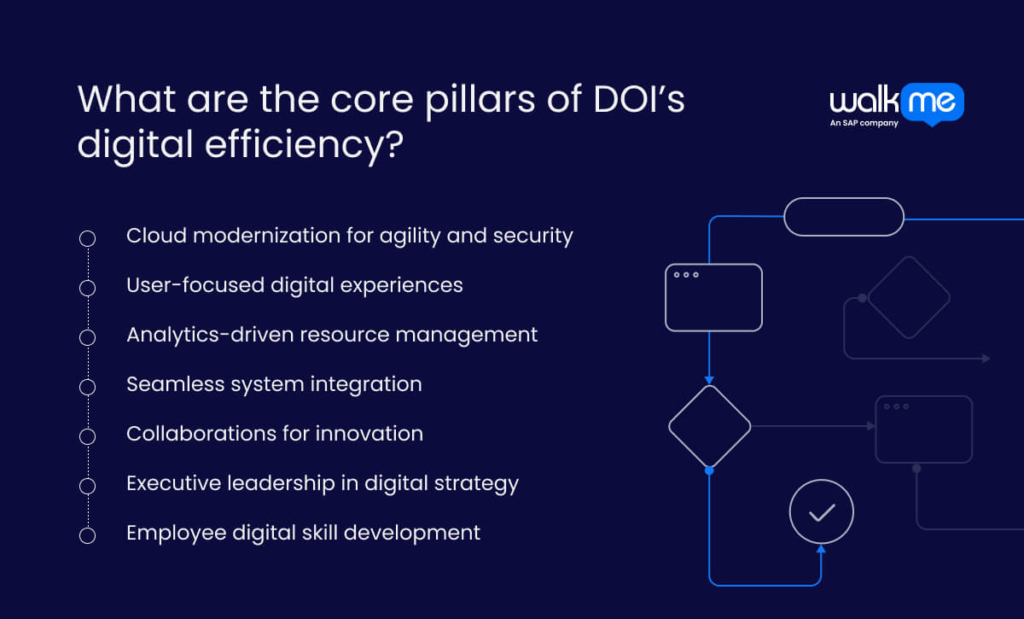The Department of the Interior (DOI) is long recognized for managing national parks, conserving cultural landmarks, overseeing water and energy resources, and stewarding public lands. Its work shapes both American heritage and everyday life.
National parks attract hundreds of millions of visitors annually, support rural economies, and conserve biodiversity. These responsibilities demand careful use of public funds.
In the digital era, improving technology systems through digital efficiency drives can deliver measurable savings and protect assets, without disrupting field operations.
In 2021, the DOI launched a five-year initiative to modernize and consolidate its IT systems. The program is projected to save approximately $500 million, funded entirely through the costs it eliminates.
This article examines digital efficiency inside one of the government’s most resource-heavy departments.
What is digital efficiency in the Department of the Interior?
Digital efficiency in the Department of the Interior (DOI) means using modern technology to manage resource allocation, digital services, and internal operations with less waste and greater precision. It helps the department do more with limited budgets and staff.
One clear example comes from the DOI’s adoption of web APIs to share real-time environmental data. The National Water Information System (NWIS) and the Real‑time Earthquake Information feed were made available via APIs in 2023. This allowed scientists, emergency responders, and the public to access up-to-date data without having to manage separate platforms.
This move strengthened data accuracy and expanded access, achieving these benefits through existing budgets and staff. Digital efficiency helps the DOI honor its mandate while keeping taxpayer interests front and center.
Why is digital efficiency important in the Department of the Interior?
Digital efficiency means reducing waste and enhancing the Department of the Interior’s ability to handle its complex tasks.
Shifting from manual paperwork to digital tools saves money, offers greater ROI, and reduces errors. It also allows employees to spend more time on conservation and enterprise resource planning (ERP).
For instance, the Bureau of Land Management (BLM) uses a mobile app called S1 Mobile Mapper to make field inspections easier. Rangers and staff can collect and update location data right on their devices, even without internet access. Once they’re back online, the app automatically sends the information to the main system.
In this regard, digital efficiency enables the DOI to protect public lands and deliver services with a clear and responsible use of resources.
How has DOI improved operations through digital efficiency?
The Department of the Interior has focused on improving operations through targeted digital efficiency initiatives. Understanding these efforts reveals how the department manages resources and meets public needs in a complex, resource-intensive environment.
Let’s take a closer look at how the DOI improved operations through digital efficiency:
Modernizing web services
Many of the department’s websites and internal tools were outdated and difficult to use. Updating them to work well on mobile devices means more people can quickly access permits, maps, and reports without delays. These new platforms handle heavy user traffic without crashing. As a result, staff spend less time resolving technical problems and more time focusing on managing public lands and resources.
Expanding data access and security
The DOI moved its important information to a central, secure cloud ecosystem. This change helps teams across different offices find the data they need much faster. Stronger safety measures protect this data from unauthorized access, reducing the risk of security breaches. Quicker access alongside enhanced security boosts the department’s ability to coordinate operations and respond to challenges.
Expanding citizen engagement
Interacting with the department used to mean visiting offices or filling out paper forms. New online tools now enable citizens to apply for permits, submit feedback, and report issues from the comfort of their own homes or on their mobile devices. This change reduces paperwork and shortens waiting times. It also makes it easier for people to stay involved in decisions about parks, wildlife, and cultural sites.
Strengthening connectivity
Offices and field teams often worked with slow or unreliable internet connections. Investing in better, secure networks and satellite communication allows for the instant sharing of data and video meetings. Field staff can update records and get support in real time, even from remote locations. For example, enhanced network reliability allows field teams to instantly share wildfire updates and coordinate firefighting efforts, speeding response times during critical incidents.
What role do cloud and data play in DOI’s efficiency?

Let’s take a closer look at the role of the cloud and data in DOI digital efficiency:
Updating operations with cloud technology
Migrating key systems like the Financial and Business Management System (FBMS) to the cloud allows the DOI to manage workloads more flexibly.
With support from Unisys and Virtustream, the DOI became the first federal agency to host its SAP-based financial platform in the cloud. That change led to on-demand resource scaling and cut physical server costs. Users reported fewer outages and faster financial reporting.
Leveraging data analytics for smarter decisions
Applying big data analytics helps DOI teams spot patterns in water usage and weather events. For example, hydrologists now use statistical models to predict river flows ahead of crucial irrigation seasons.
As a result, they schedule water releases more accurately and reduce waste. An official DOI report shows how machine learning methods outperformed traditional forecasts. This enabled teams to predict water flows more accurately and manage hydropower resources more efficiently.
Ensuring secure, seamless data sharing
The DOI consolidated 14 separate email systems and migrated 70,000 users to one cloud-based platform called BisonConnect. This project standardized access controls and encryption across all users.
Staff now enjoy consistent login procedures, and security teams can monitor threats centrally. According to the DOI’s Office of the Chief Information Officer, this consolidation helped shrink the email attack surface and strengthen protection without disrupting daily work.
Enhancing public engagement through digital tools
Digital tools, such as interactive maps and online comment portals, make it easier for the public to stay informed, share their input, and follow project updates. For example, the Bureau of Reclamation tested AI models to forecast river flows up to 10 days in advance.
These models improve accuracy across multiple basins, helping to avoid wasted water and support smarter use of natural resources.
What are the core pillars of DOI’s digital efficiency?

Let’s look at the core pillars driving digital efficiency, arguably the most important part:
Cloud modernization for agility and security
The DOI has made an effort to move important systems to the cloud. This change helps them react quickly to new demands and keeps data safe from hackers with strong protections. Using the cloud means they don’t need redundant computers and can grow their resources when needed without risk.
User-focused digital experiences
The DOI creates websites and digital tools with customer centricity in mind. Whether someone is applying for permits or staff are managing projects, the platforms are designed to be simple and easy to use. Clear instructions and straightforward layouts reduce confusion and save time. This helps everyone to find information more quickly and complete necessary tasks.
Analytics-driven resource management
Data analysis helps the department make smarter decisions about managing water, land, and wildlife. Studying patterns and predicting changes, staff can plan ahead to avoid issues. For example, predicting river flow helps schedule water releases more accurately, supporting farmers and protecting ecosystems. Using data in this way allows the department to save resources and improve conservation efforts.
Seamless system integration
Different digital systems within the DOI are connected to share information. Instead of working in isolation, staff can access all the data they need from one place. This reduces mistakes caused by switching between multiple platforms and speeds up tasks. System integration also helps teams work more efficiently and coordinate their efforts better.
Collaborations for innovation
Collaborations with universities, technology companies, and other agencies bring fresh ideas and expertise to develop new digital tools. Working together enables testing and refining of these technologies to ensure they meet real-world needs. Such partnerships accelerate digital innovation and help improve how the Department of the Interior operates, making its digital efforts more effective and practical.
Executive leadership in digital strategy
Strong leadership from top officials is key to the DOI’s digital success. Leaders set clear goals, provide funding, and keep teams accountable. Their support ensures that digital adoption projects align with the department’s overall mission and receive the attention needed to succeed. Executive involvement helps drive focus and momentum for important technological changes.
Employee digital skill development
Employee training programs help department employees learn how to use new digital tools and software. Building these skills gives staff the confidence to work efficiently and adapt to changes. Ongoing education ensures employees stay up to date with evolving technology, which improves overall performance and helps the department keep pace with modern demands.
How does DOI build trust through digital transparency?
Trust and transparency are essential for technology projects, especially in public-facing departments like the DOI.
Building trust requires clear and efficient digital systems. The following sections will explore how the DOI uses digital efficiency to strengthen public confidence and deliver more reliable services. Let’s take a closer look:
Open data initiatives
The DOI shares large amounts of data openly online, letting anyone access information about lands, wildlife, and projects. This openness helps people verify facts and understand how decisions are made. Making data available builds trust by showing the department has nothing to hide and supports public involvement.
Transparent communication
Clear, honest updates about projects and policies help the DOI stay accountable. The department posts regular reports and explains decisions in simple language. Sharing both successes and challenges openly shows respect for the public and helps build confidence in the department’s work and goals.
Responsive digital platforms
Online services that quickly answer questions and handle requests show the DOI values public input. Easy-to-use websites and timely replies also reduce software frustration. When people see their concerns addressed promptly, it encourages ongoing participation in land management.
What future trends will shape DOI’s digital efficiency?
Because the Department of the Interior covers such a wide range of responsibilities, it remains one of the more resource-intensive parts of government.
Its work is essential, and as this article has shown, ongoing investment in large-scale technology is key to meeting that responsibility.
Initiatives like the Cloud Program and the use of real-time data are just a few ways the DOI is pushing beyond routine upgrades to improve digital efficiency.
In the future, we expect to see more integrated systems and smarter digital services. That will lead to faster responses, better coordination, and stronger public trust.
Given time and investment, this should have a long-term impact across conservation, infrastructure, and public access.
FAQs
Switching to modern systems hasn’t been a quick process. Many tools had to work with outdated software that was still in use. Staff needed time and training to adjust to the new system. This meant budget limits traditionally slowed some upgrades. Balancing daily responsibilities while updating systems also added pressure across departments, especially in remote offices with poor connectivity.
The Bureau of Land Management (BLM) now uses mobile GIS tools like ArcGIS Field Maps and S1 Mobile Mapper. These apps allow field staff to collect geospatial data offline and sync directly with national GIS systems. This workflow reduces mistakes and improves data accuracy, making field reporting faster and more reliable.
DOI uses tools like multi-factor authentication and encrypted cloud storage to protect sensitive files. For example, staff accessing land or wildlife data log in through secure portals using PIV cards. Public data is kept on separate systems from internal records. Cybersecurity teams monitor threats constantly, blocking over 5 million malicious attempts each week.

